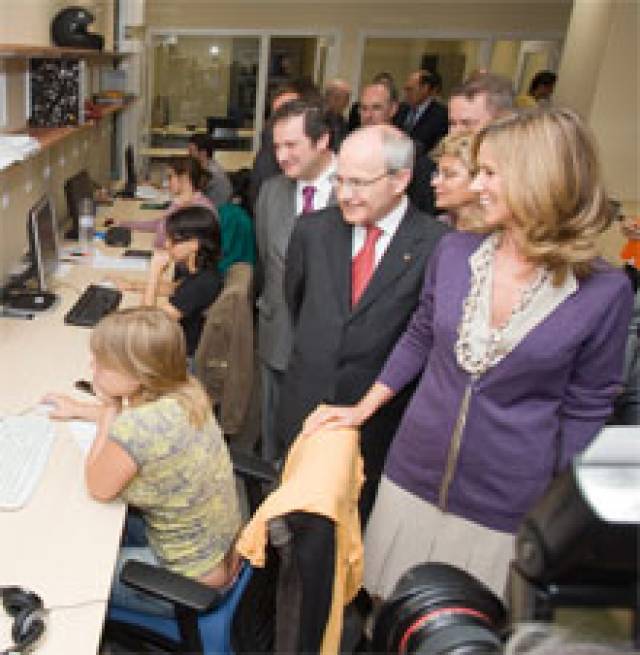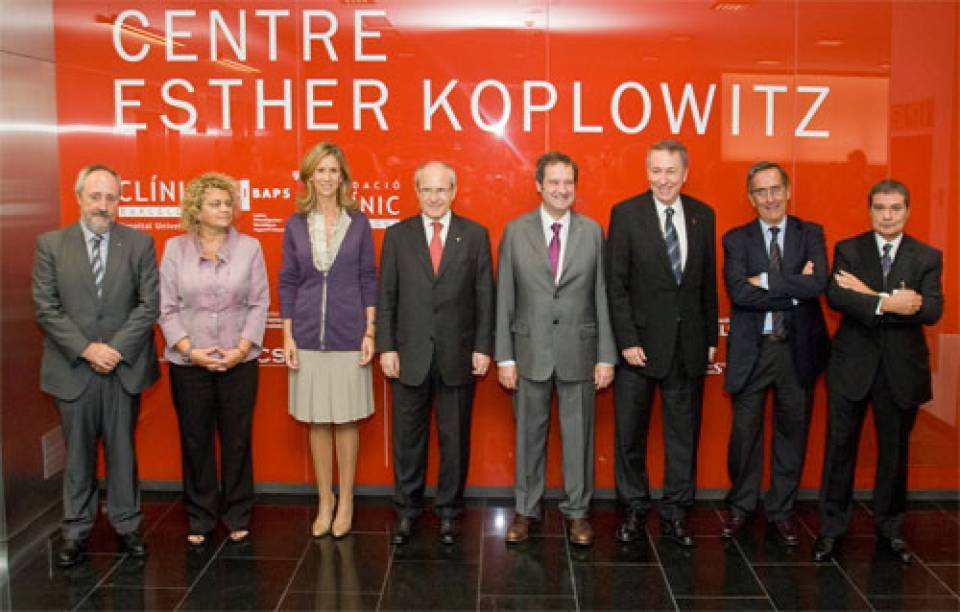Esther Koplowitz Center is the new building where researchers from Hospital Clínic of Barcelona, the Faculty of Medicine of the University of Barcelona and the Institute for Biomedical Research of Barcelona of the CSIC (IIBB-CSIC), who unite their efforts in the Institut d'Investigacions Biomèdiques August Pi i Sunyer (IDIBAPS), together with the Center for International Health Research (CRESIB) will reach their full scientific potential.
The construction of this center was made possible by the initial contribution of Esther Koplowitz Foundation. The donation, worth over EUR 15 million for the construction of the building, is the most important patronage to scientific research conducted in Spain, and one of the most outstanding in Europe. The construction and equipping of the building represents an investment of more than EUR 60 million.
The contribution of Esther Koplowitz Foundation to the Hospital Clínic of Barcelona, through the Fundació Clínic, was presented in December 2005. Works began in February 2008 and ended last September.
Esther Koplowitz Center is the result of the sum of three initiatives: firstly the doctors at the Hospital Clínic, through the Fundació Clínic, bought a plot next to the hospital to build a research center; secondly, Esther Koplowitz funded through her Foundation the construction of the building; and last but not least, the support of the (Catalan Government (Generalitat de Catalunya), the Ministry of Science and innovation, the Carlos III Health Institute and the University of Barcelona. This project has also involved the collaboration of other patrons as Cellex Private Foundation, Acció Sardà Farriol for Research in Diabetes (ASF) and Laboratoris Esteve.
A translational model linking public and private efforts

Esther Koplowitz Centre promotes a modern conception of biomedical research that links basic and clinical research in a competitive and efficient way. Its proximity to the Hospital Clínic makes it particularly suitable for competitive translational research and transference. The work spaces were designed to meet the needs of cutting-edge biomedicine, with common areas designed to facilitate interaction and support platforms available.
A building for biomedical research

The ground floor and attic are dedicated to common uses (cafeteria, auditorium, security, concierge, reception, direction of Esther Koplowitz Center, IDIBAPS and Fundació Clínic, administrative support structures for researchers, visitors reception, clothing, seminars ...). The floor of the basement and five upper floors are devoted to research laboratories, laboratories for technological innovation and platforms to support research (genomic, transcriptomic, proteomics, bioinformatics, and cryopreservation cytometry). Basements 1 and 2 will be devoted to storage areas and parking of vehicles.
The building optimizes energy consumption with solar energy capture and lighting technology with an innovative low-power LEDs.
International Collaborations

Of note is the growing presence on research projects funded by the European Commission of researchers that will work in the Esther Koplowitz Center. In 2009 there were 13 projects coordinated by members of the IDIBAPS, 6 of them granted in 2009, and nearly 50 more participated. The success rate achieved in the European calls for IDIBAPS professionals and its European Projects Office is available to very few institutions. In 2009, the European Commission provided 40% of the projects requested by IDIBAPS, while the European average is around 17%.
Excellence research lines
The main lines of work already underway within the IDIBAPS will be enhanced thanks to the laboratories and the latest technological equipment of the new building. In the Esther Koplowitz Center, rising young talents and international leaders will develop their research in the best conditions.
The Esther Koplowitz Centre is crowded with first international figures for the study of: Metabolism, Diabetes and Obesity, Diseases of the digestive system and liver, Hematology and Oncology, Poverty-related diseases and Immunology.
Esther Koplowitz Foundation
Created in December 1995 to help the most disadvantaged in society, the Foundation led to the institutionalization of social activity that its founder, Esther Koplowitz, has developed ever since.
The Foundation is funded solely from contributions made by Esther Koplowitz and is considered "Social Charitable Organization” by the Ministry of Labour and Immigration. To date, donations from the Esther Koplowitz Foundation are around one hundred million euros.
Besides the boost to medical research that involves the creation of the Center Esther Koplowitz, Esther Koplowitz Foundation has made various contributions such as the Da Vinci Robot donation to the Hospital Clínico San Carlos of Madrid.
The activities and partnerships developed by the Foundation, directly or with other associations, are numerous and are aimed at addressing the needs of the poorest in society. His most significant initiatives are developed for the elderly and people who have some type of physical or mental disabilities and elderly ones whose families lack the means to help them. These needs arise the idea of constructing and equipping three residences in Madrid, Barcelona and Valencia, to improve the quality of life of these people who were subsequently donated to the Administration. Soon a new home in Valladolid and another in Valencia will be built.

